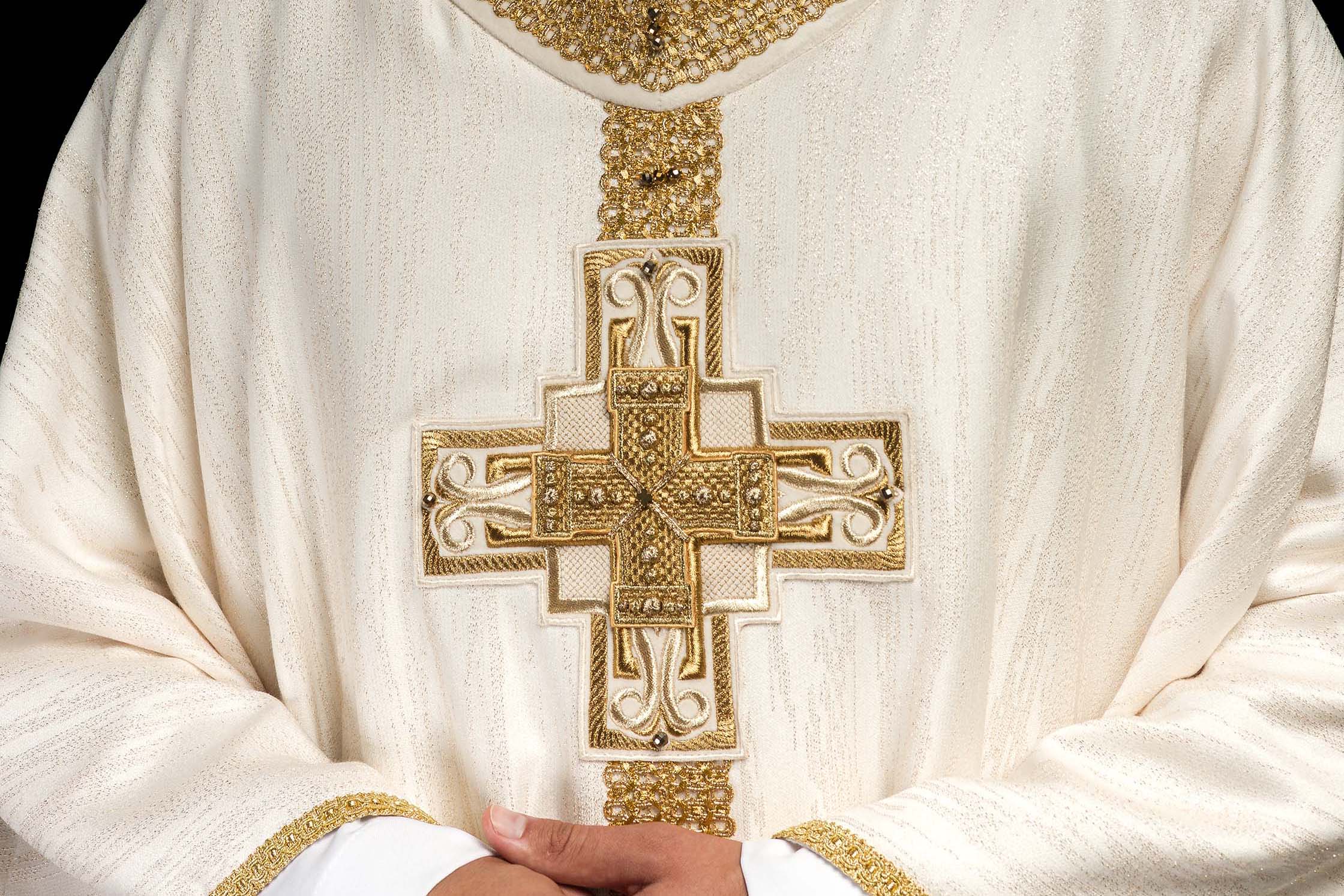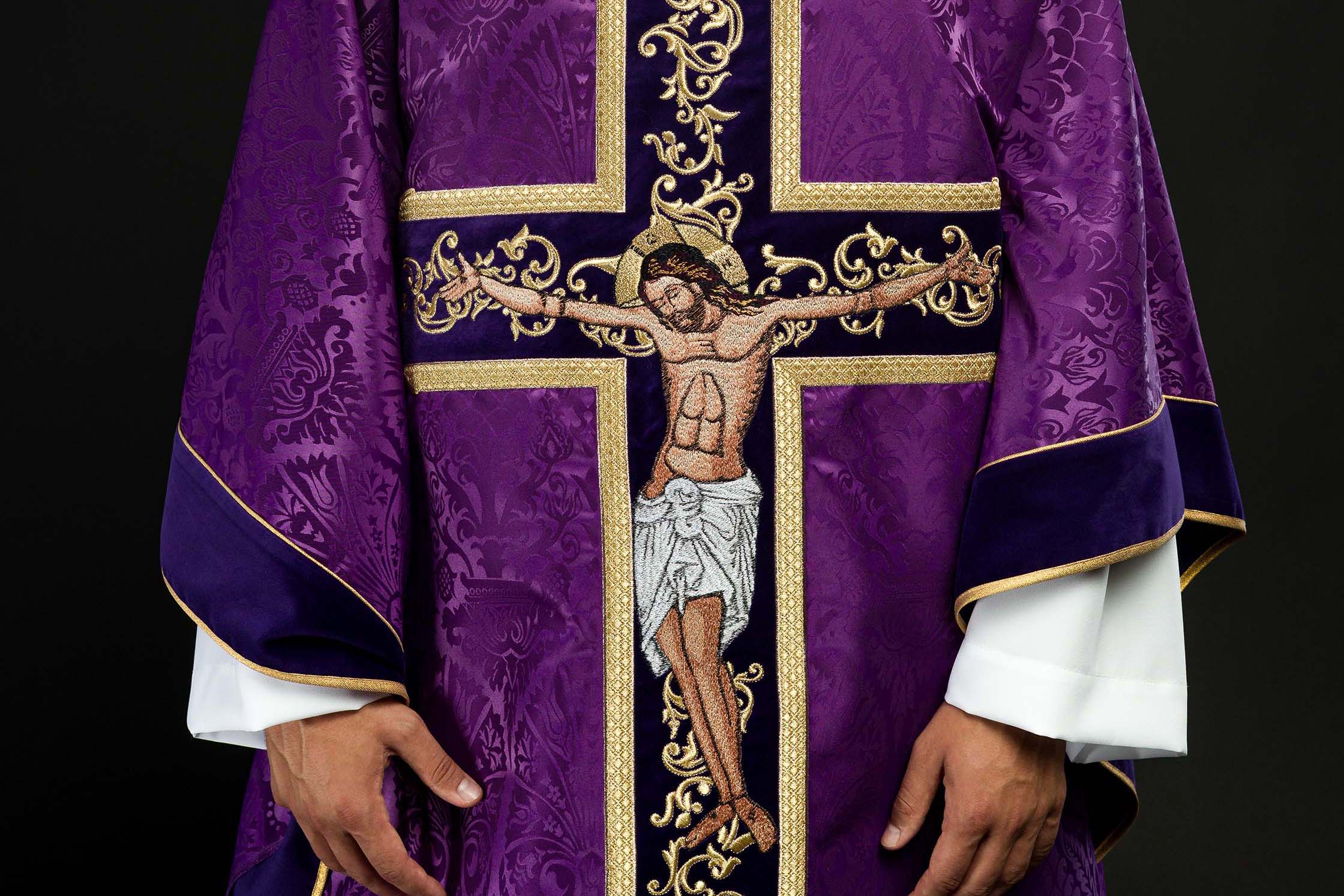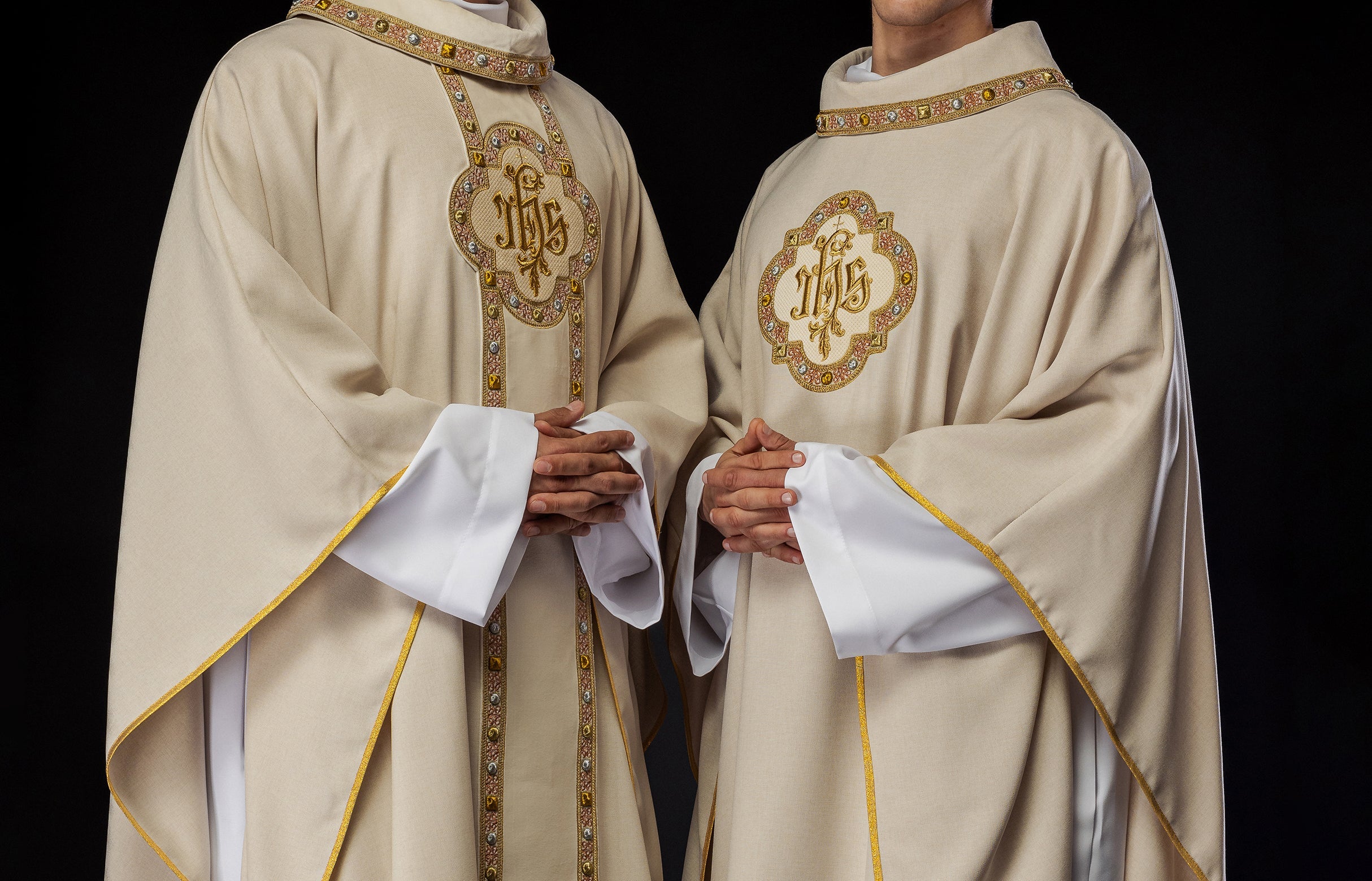
Hand-Embroidered vs. Machine-Embroidered Vestments: Which Should You Choose?
Hand-Embroidered vs. Machine-Embroidered Vestments – Which to Choose?
Choosing between a hand-embroidered and a machine-embroidered vestment is a decision that affects aesthetics, durability, and liturgical symbolism. Both approaches have their unique advantages and specifics that may be important for the final visual effect, durability, and price. In this article, we will take a closer look at these two methods of decorating liturgical garments, analyzing their key differences to facilitate making an informed decision. Our goal is to provide comprehensive information to help you choose the ideal vestment, reflecting the solemnity of the liturgy and the aesthetics of a given parish or community.
Hand Embroidery – Craftsmanship and Tradition
Hand embroidery, also known as artistic or traditional embroidery, is a technique with a centuries-old tradition that forms the foundation of decorating liturgical garments. This process involves precisely embroidering patterns using a needle and thread, often by skilled artisans who spend many hours creating a single piece.
Key Features of Hand Embroidery:
- Uniqueness and Individuality: Each hand embroidery is unique. Even with a repeating pattern, subtle differences in the arrangement of threads or the depth of the stitch give it a unique character. It is a work of art, not just a product.
- High Quality Materials: High-quality, natural threads such as silk or cotton are often used, as well as metallized (gold, silver) threads, which add splendor and durability. In some cases, hand embroidery may include the use of precious or semi-precious stones, which further increases its value.
- Precision of Details: Hand execution allows for achieving extraordinary precision in rendering details, subtle tonal transitions, and nuances of the pattern. Even the smallest elements of ornamentation can be embroidered.
- Durability: Properly executed hand embroidery is extremely durable and resistant to mechanical damage or fading. Properly cared for, it can last for many generations.
- Depth and Three-Dimensionality: Hand stitches can create the impression of depth and three-dimensionality, giving the embroidery a richness and texture that are difficult to achieve with other methods.
- Time Consumption and Cost: The main disadvantage of hand embroidery is its time consumption, which naturally translates into a higher product price. Creating a complex pattern can take many days or even weeks of work.
When to Choose Hand Embroidery?
Hand embroidery is an ideal choice when you value the highest quality, uniqueness, and traditional craftsmanship. It is an excellent option for important celebrations, anniversaries, as well as for parishes and communities that want to own liturgical garments of exceptional artistic and symbolic value. It is especially recommended for the most representative vestments, which are to be a testimony of faith for many years.
Machine Embroidery – Modernity and Efficiency
Machine embroidery is a technology that has revolutionized the production of clothing, including liturgical garments. Thanks to advanced computer machines, it is possible to quickly and precisely reproduce complex patterns, which significantly affects the availability and price of products.
Key Features of Machine Embroidery:
- Speed and Production Efficiency: Embroidering machines are able to perform complex patterns in a much shorter time than manual execution. This allows for the production of a larger number of pieces in a shorter period.
- Precision and Repeatability: Computer-controlled machines guarantee perfect repeatability of the pattern. Each element of the embroidery is made with the same precision, which is important when creating complete sets of garments.
- Wide Range of Patterns and Embroideries: Modern machines allow for creating very complex and detailed embroideries, including the use of many colors of thread, and even 3D embroideries or with the use of specialized techniques, such as embroidering with metallic threads.
- Lower Cost: Due to less labor intensity and greater production speed, garments with machine embroidery are usually more affordable than their hand-embroidered counterparts.
- Variety of Materials: Machine embroidery works perfectly on various types of fabrics, from delicate silks to thicker materials, while maintaining high quality finishing.
- Potential Detail Limitations: Although machine embroidery is very precise, some very subtle tonal transitions or three-dimensional effects may be more difficult to obtain compared to hand embroidery. Sometimes too high a density of stitches can make the embroidery stiffer.
When to Choose Machine Embroidery?
Machine embroidery is an excellent solution when you want to obtain a high-quality, aesthetic and durable vestment at a reasonable price. It is an ideal choice for parishes that need a larger number of garment sets, or when the budget is limited, but we still want to enjoy beautiful and symbolically rich embroidery. Modern machine embroidery techniques allow for creating very impressive and detailed patterns that look great on liturgical garments.
Comparison of Key Aspects
To facilitate the decision, here is a summary of the key differences between hand and machine embroidery:
| Aspect | Hand Embroidery | Machine Embroidery |
|---|---|---|
| Uniqueness | High, each piece is unique | Repeatability, each embroidery is identical |
| Quality of Details | Very high, subtle tonal transitions | High, precise reproduction of the pattern |
| Durability | Very high, with proper care | High, depends on the quality of threads and execution |
| Production Time | Long, time-consuming | Short, efficient |
| Cost | High | Lower, more affordable |
| Aesthetics | Depth, texture, artistic character | Clarity, precision, modern look |
| Symbolism | Emphasizes value and dedication | Focuses on fidelity to the pattern and symbolism of a given motif |
Embroidered Chalice Linen and Other Accessories
It is worth noting that embroidery techniques – hand and machine – are also used to decorate other liturgical elements, such as chalice linen (pall, corporal, purificator), chalice veils, altar cloths or stoles. In the case of smaller elements, where decorations are usually more modest, machine embroidery is often preferred due to its precision and cost. However, for particularly solemn sets, where every detail matters, hand embroidery can add a unique character.
Examples of Embroidered Products at HAFTINA TEXTILE GROUP SP. Z O. O.:
In the offer of our company, HAFTINA TEXTILE GROUP SP. Z O. O., you will find a wide selection of liturgical garments decorated with both hand and machine embroidery. We offer a wealth of embroidered motifs, from traditional Christian symbols, such as IHS, the Easter Lamb, or Marian motifs, to more contemporary designs. Our products are characterized by high quality of materials used and precision of workmanship, regardless of the embroidery technique used.
- Vestments: Both those with intricate hand embroidery and modern, effective machine patterns are available.
- Stoles: A wealth of colors and embroideries, from simple symbols to complex compositions.
- Chalice Linen: Made of the best materials, with embroidered symbols that emphasize the sacred character of the liturgy.
- Chalice Veils: A complement to the celebration, often decorated with embroideries referring to the vestment or stole.
Summary: How to Make the Best Choice?
The final choice between a hand-embroidered and a machine-embroidered vestment depends on individual priorities, budget, and the aesthetics you want to achieve.
- If you are looking for a work of art that will be a spiritual heritage for future generations, you value uniqueness and unlimited precision of details, and the budget is not the main limitation, choose hand embroidery.
- If the priority is high quality, beautiful, modern look, durability and affordable price, choose a vestment with machine embroidery.
Regardless of the decision, it is crucial to choose products from proven manufacturers who guarantee high quality of workmanship and materials. At HAFTINA TEXTILE GROUP SP. Z O. O., we make every effort to ensure that our liturgical garments, regardless of the embroidery method, meet the highest standards and serve during celebrations for many years.
We invite you to familiarize yourself with our rich offer of vestments and other liturgical garments on the website haftinausa.com, where you will find detailed product descriptions, a variety of patterns and colors, as well as inspiration for your liturgical needs.
```




